Unit 1 Welcome to the unit & Reading 课件-牛津译林版(2020)选修第一册
文档属性
| 名称 | Unit 1 Welcome to the unit & Reading 课件-牛津译林版(2020)选修第一册 |

|
|
| 格式 | pptx | ||
| 文件大小 | 51.0MB | ||
| 资源类型 | 试卷 | ||
| 版本资源 | 牛津译林版(2019) | ||
| 科目 | 英语 | ||
| 更新时间 | 2024-05-09 12:19:11 | ||
图片预览

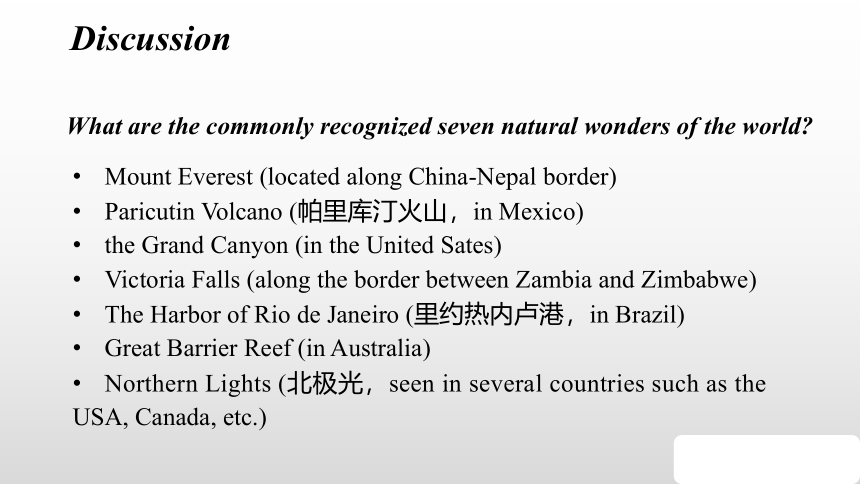
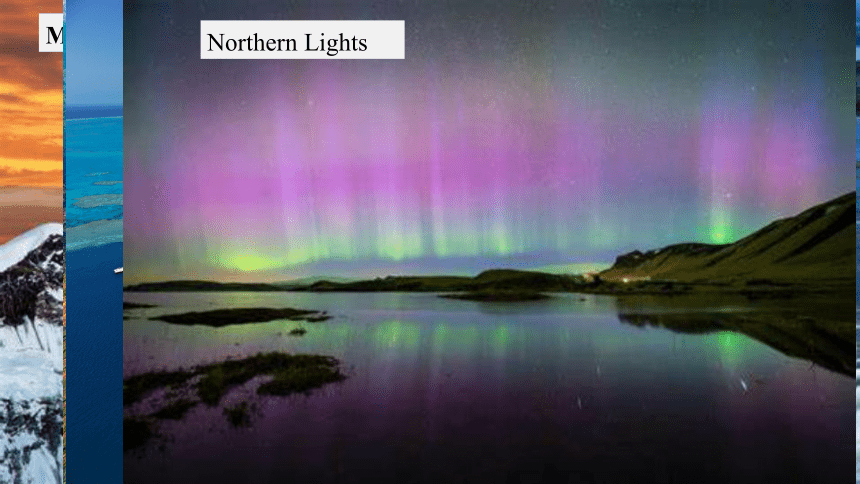
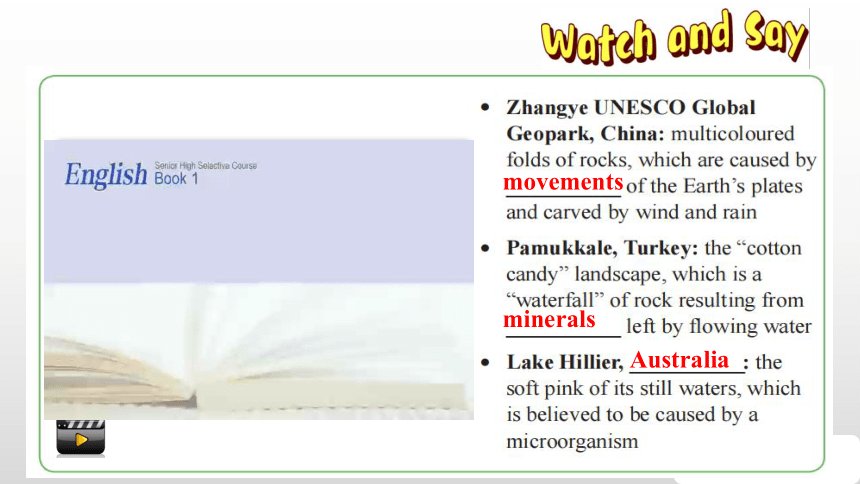
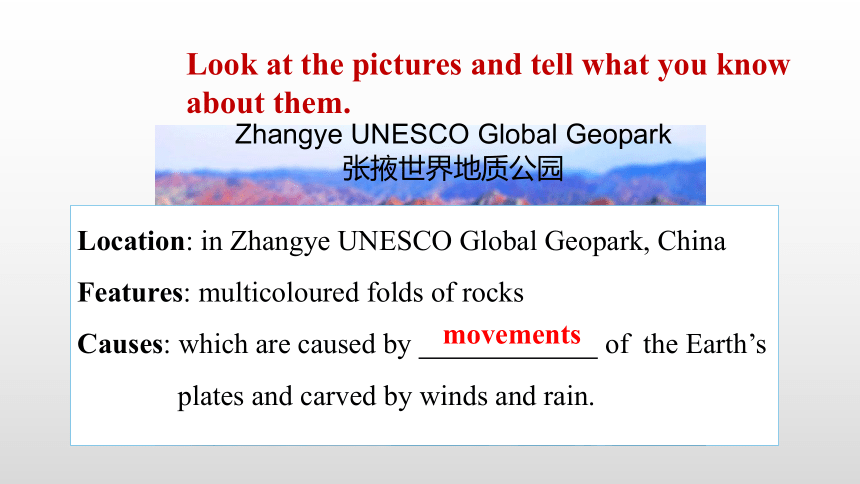
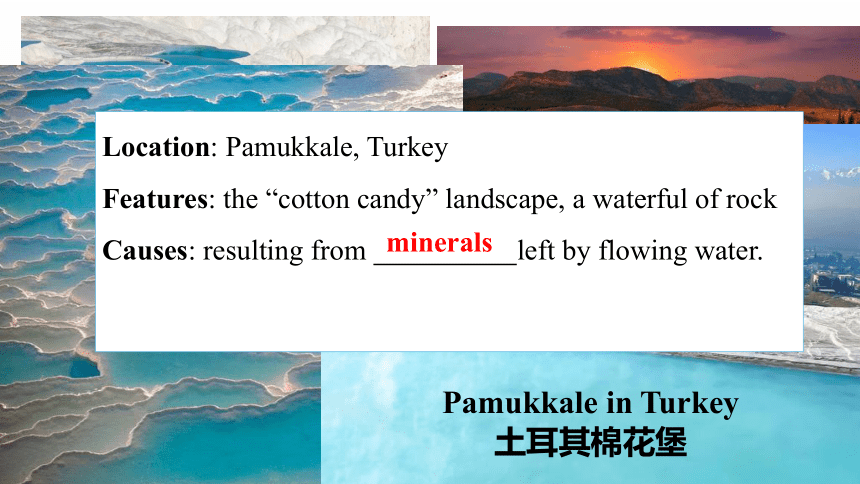
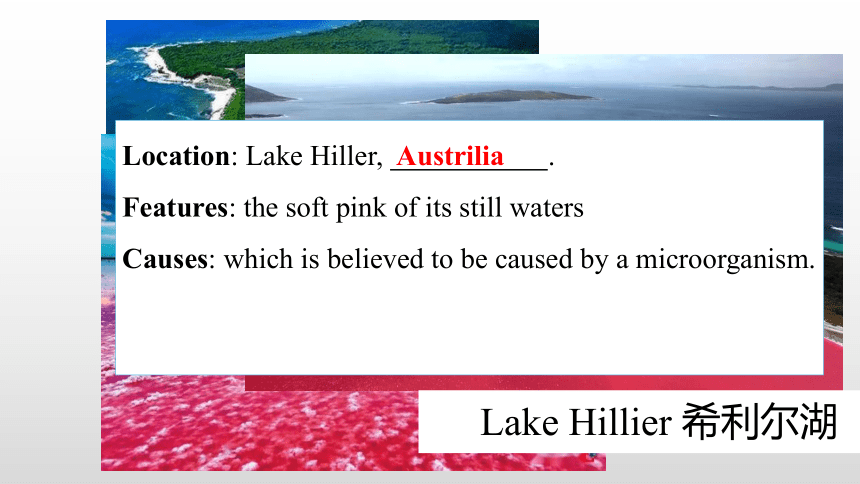

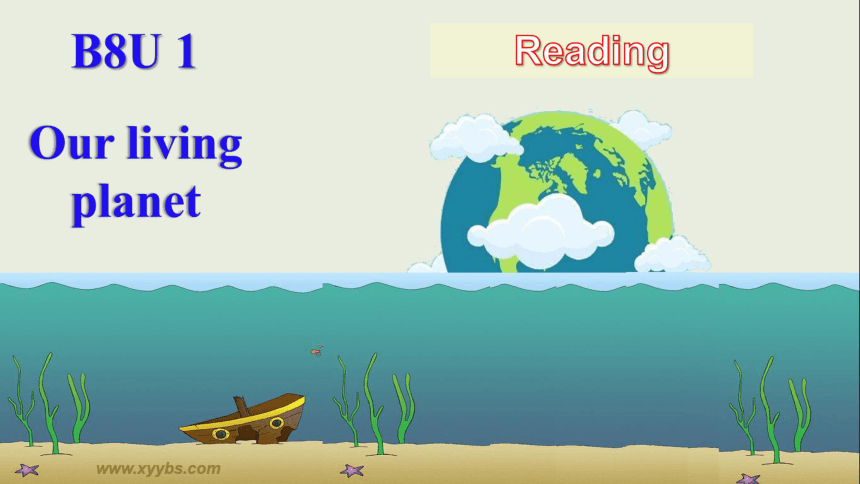

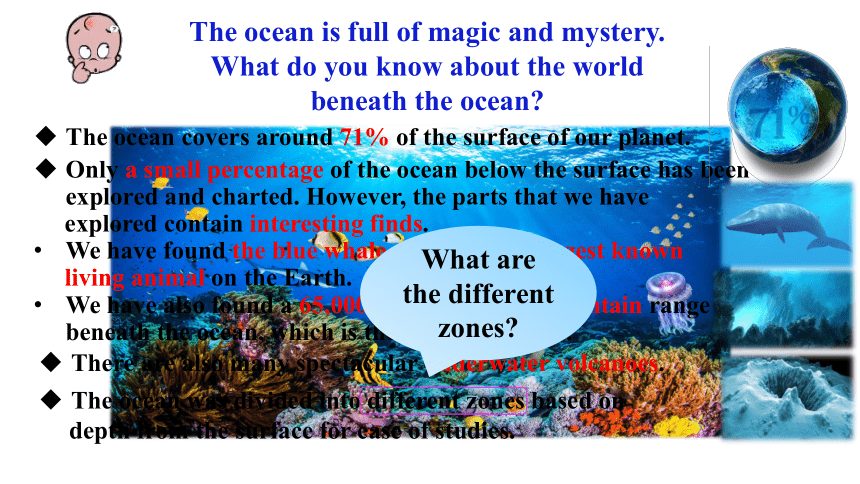
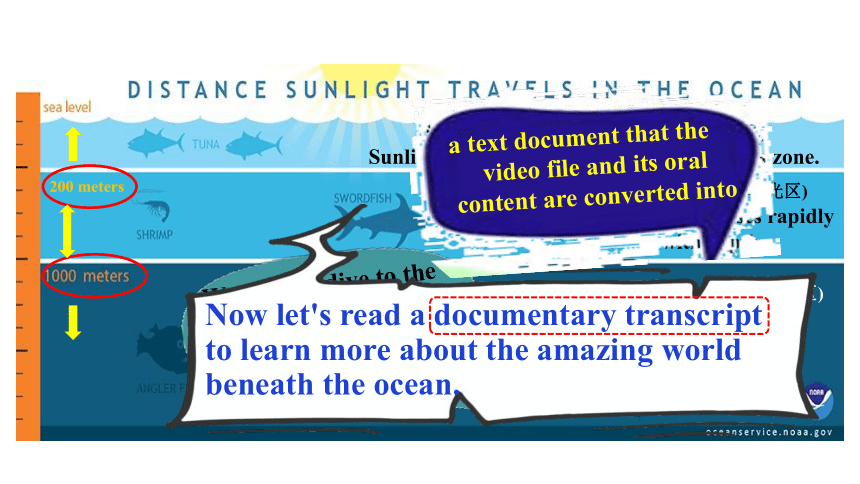
文档简介
(共50张PPT)
B8U1
Our living planet
Welcome to the unit
What are the commonly recognized seven natural wonders of the world
Discussion
Mount Everest (located along China-Nepal border)
Paricutin Volcano (帕里库汀火山,in Mexico)
the Grand Canyon (in the United Sates)
Victoria Falls (along the border between Zambia and Zimbabwe)
The Harbor of Rio de Janeiro (里约热内卢港,in Brazil)
Great Barrier Reef (in Australia)
Northern Lights (北极光,seen in several countries such as the USA, Canada, etc.)
Mount Everest (located along China-Nepal border)
Paricutin Volcano (in Mexico)
the Grand Canyon (in the United Sates)
Victoria Falls (along the border between Zambia and Zimbabwe)
The Harbor of Rio de Janeiro (in Brazil)
Great Barrier Reef (in Australia)
Northern Lights
movements
minerals
Australia
Look at the pictures and tell what you know about them.
Zhangye UNESCO Global Geopark
张掖世界地质公园
Location: in Zhangye UNESCO Global Geopark, China
Features: multicoloured folds of rocks
Causes: which are caused by of the Earth’s
plates and carved by winds and rain.
movements
Pamukkale in Turkey
土耳其棉花堡
Location: Pamukkale, Turkey
Features: the “cotton candy” landscape, a waterful of rock
Causes: resulting from left by flowing water.
minerals
Lake Hillier 希利尔湖
Location: Lake Hiller, .
Features: the soft pink of its still waters
Causes: which is believed to be caused by a microorganism.
Austrilia
In all things of nature there is something of the marvellous.
- Aristotle
自然界包罗万象,蕴藏着奇妙之处。
——亚里士多德
B8U 1
Our living planet
Reading
The ocean is full of magic and mystery.
What do you know about the world
beneath the ocean
The ocean covers around 71% of the surface of our planet.
Only a small percentage of the ocean below the surface has been explored and charted. However, the parts that we have
explored contain interesting finds.
We have found the blue whale, which is the largest known
living animal on the Earth.
We have also found a 65,000-kilometre-long mountain range beneath the ocean, which is the world’s longest.
There are also many spectacular underwater volcanoes.
The ocean was divided into different zones based on depth from the surface for ease of studies.
What are the different zones
200 meters
The open ocean/Sunlight zone (透光区)
Sunlight rarely penetrates(穿透) beyond this zone.
Twilight zone(暮光区)
Sunlight decreases rapidly with depth.
The deep ocean(深海区)
Sunlight does not penetrate at all.
Would you dive to the ocean bottom if you had the chance Why or why not
Now let's read a documentary transcript
to learn more about the amazing world beneath the ocean.
a text document that the video file and its oral content are converted into
Read and finish the tasks as quickly as possible.
Task 1
Much of the known marine life lives in the open ocean, and small filter feeders and hunters live in the twilight zone.
The deep ocean is home to the strangest creatures on the Earth.
Shrimps and other organisms live around hydrothermal vents, and the Mariana Trench can be found on the ocean floor.
More wonders beneath the surface of the ocean await us.
P4
A1
Task 2
True or false.
1. The first 100 metres of our dive takes us through what can be called the open ocean. T / F
2. Sinking above 200 metres, we enter the twilight zone, where there is little sunlight and thus no plant life. T / F
3. Once past 1,000 metres, we have reached the deep ocean, where there is no light and temperatures drop just below freezing. T / F
4. In the deep ocean, some fish have both male and female organs to increase the chances of reproduction. T / F
5. The Challenger Deep, is nearly 11,000 metres below sea level.
T / F
200
below
above
almost
Task 3
Para. 1
1. What percentage of the world’s oceans have we explored Why
2. Why does the author mention exploring space
P4
A2-1
1. What percentage of the world’s oceans have we explored Why
Less than 20%. Human beings have a passion for exploring the deepest point under the ocean. However, the conditions are extreme. The pressures are huge and there is no light.
Some unusual creatures also live there. Moreover, advanced technologies need to be researched and developed to help us explore the ocean more effectively.
Possible answer:
2. Why does the author mention exploring space
Because the author wants to emphasize that the ocean should be explored and is well worth exploring just like deep space. We know more about outer space than the ocean. The ocean is full of mysteries, waiting to be solved.
Para. 2
1. What do small filter feeders do at night
2. How do you understand the last sentence “Evolution, it seems, helps both the hunter and the hunted in equal measure!”
They swim up to feed in the nutrient-rich waters above.
The sentence emphasizes the function of evolution. It helps the hunter evolve unique characteristics, which can allow them to catch the prey more easily. However, it also helps the prey evolve survival characteristics and get away from the hunter.
Possible answer:
P4
A2-2
Para. 3
How do blind creatures in the deep ocean manage to survive
They depend on other senses such as smell and their ability to detect slight changes in water pressure to obtain food and avoid being caught.
Possible answer:
P4
A2-3
Para. 4
1. What has changed scientific opinion about the chances of there being life elsewhere in the universe
2. Why does the author mention Mount Qomolangma when describing the Challenger Deep
The knowledge that life can exist in the extreme conditions on the ocean floor.
Possible answer:
The author wants to highlight how deep the Challenger Deep is. By comparing it to the highest mountain in the world, Mount Qomolangma, the author helps the reader visualize its depth.
P4
A2-4
P4
A3-1
Zones Depths Environment Life forms or
geological formations
The open ocean
The twilight zone Little sunlight ● Almost no plant life
● Small filter feeders
● ______________________
The deep ocean ● No light ● ____________ _______________ ● Huge pressures ● Blind, strange organisms, and some having male and female organs
● Shrimps and other organisms
●
Task 4
Complete the following table.
1,000 metres to the ocean floor
Hunters with telescopic, upward-pointing eyes and backward-curving teeth
0 to 200 metres
Most visible light
200 metres to 1,000 metres
Much of the known marine life
Temperatures just above freezing
Hydrothermal vents, the Mariana Trench and rock bridges
Check your answers:
Write a summary of the transcript in no more than 100 words according to the table.
The ocean mainly consists of three different zones. The first 200 metres just below the ocean surface can be called the open ocean, where much of the known marine life lives and most visible light exists. The twilight zone is below 200 metres, where with little sunlight, there is almost no plant life, and small filter feeders and hunters live. Past 1,000 metres, we have reached the deep ocean, where many strange creatures can be found living in this extreme environment. On reaching the ocean floor, we may see shrimps and other organisms around hydrothermal vents. The famous Mariana Trench can be found in this zone.
Possible answer:
Task 5
Think and share.
At the end of the first paragraph, a question is asked, and at the end of the last paragraph, another question is asked. What is the author’s purpose of writing in this way
Para. 1
Para. 5
The first paragraph aims to attract the reader to the topic of deep-sea exploration by asking the question: “Then why don’t we dive to the bottom of a really deep ocean and take a long, close look beneath the waves ”
The last paragraph serves as a conclusion. After describing the ocean deep, the author gives an ending to this documentary transcript. By asking the question: “... who knows what wonders still await us in the future ”, the author reminds the reader that the exploration of the unknown part of the ocean will never come to an end.
Possible answer:
Task 6
Learn about the writing technique of describing something in spatial order.
The documentary transcript describes the ocean in the surface-to-bottom order, which makes its content more organized and easier to follow. Find the expressions indicating the changes in position.
P5
B2
analysing, mindmap, summary, retelling
Analyse the features of the documentary transcript.
Introduction
Conclusion
Main body
1. a very clear structure
2. Organised in spatial(空间的) order ( from surface to bottom)
3. narrated in the first person ( from the perspective of a host)
4. apply some questions and exclamatory sentences(感叹句)
Language points
Language points Para1
1. the vastness of space L2
2. advance our undersatnding ...L2-3
3. it is estimated that ...L4
4. remain unshakeableL3-4
5.unusual geological formations L6
6.dive to the bottom of the ocean L7
太空的浩瀚无垠
增进对宇宙的了解
据估算
仍然不动摇
不寻常的地质构造
潜到海底
Language points Para2-3
1.in equal measure L18
2.rely solely on their eyesight to survive L22
3. evolve fascinating survival characteristics
L23
4. detect slight changes in water pressure L25
5.avoid being caught L24
察觉水压的细微变化
仅依靠视觉生存
进化出神奇的生存特征
在同样程度上
避免被捕获
Para. 4-5
1.on/upon doing L30
2. it is thought that ... L32
4. be located in L37
5. be known as L38
6. far(adj.) from L41
一…(就…)
人们认为
位于
作为……被知道
远非
as well as
in addition to sb/sth; too 除……之外;也;还
① He plays classical music, as well as pop and jazz.
② They sell books as well as newspapers.
1. So, if we want to find exciting new life forms as well as undiscovered and unusual geological formations, the ocean is where we should also be looking.
where引导的表语从句
if引导的条件状语从句
他演奏流行音乐和爵士乐,同时也演奏古典音乐。
他们既卖报也卖书。
所以,如果我们想要发现令人兴奋的新生命形式,以及未被发现的和不寻常的地质构造,海洋也是我们应该关注的地方。
Sentence analysing for better understanding.
Para1 Difficult sentences
2.The first 200 metres of our dive takes us through what
can be called the open ocean, where most visible light exists.(Para. 2)
我们下潜的头200米带我们穿过所谓的透光区,这里有大部分可见光。
visible adj. 可见的,明显的
整句类型为__________,其中,__________引导through之后的__________,并在从句中作__________,__________引导____________________,并在从句中作__________,先行词是____________________。
what
where
宾语从句
主语
主从复合句
非限制性定语从句
状语
the open ocean
Para2 Difficult sentences
3. Sinking below 200 metres, we enter the twilight zone,
where there is little sunlight and thus almost no plant life.(Para. 2)
下潜到200米以下,我们进入暮光区,这里没有阳光,因此几乎没有植物。
整句类型为__________,__________引导____________________,并在从句中作__________,先行词是____________________。
主从复合句
非限制性定语从句
where
状语
the twilight zone
Para2 Difficult sentences
4. Also living in the twilight zone are hunters with telescopic, upward-pointing eyes that can easily spot a meal in the waters above.
① Standing by the lake was a middle-aged man, who seemed to be a farmer.
② Seated at the centre of the classroom was Lily, who was practising Chinese calligraphy.
莉莉坐在教室中央,正在练习中国书法。
主语
一位看起来像农民的中年人站在湖边。
主语 hunters后面有较长的修饰语,为了使句子更为平衡,将谓语部分的动词 -ing 形式置于句首,形成倒装句。
同样生活在暮光区的还有双眼凸起向上的猎食者,它们能轻易地发现上面水域中的食物。
谓语
完全倒装句
定语从句
修饰主语
Para2 Difficult sentences
5.Consequently, the fish most likely to be eaten have evolved to have thin bodies so that they are less easily seen from below.(Para. 2)
结果,最有可能被吃掉的鱼已经进化成细长的身体,从下面不太容易看见它们。
整句类型为__________,__________引导____________________,另外,most likely to be eaten是形容词短语作后置定语,修饰__________。
主从复合句
状语从句
so that
the fish
consequently adv. 结果,所以
be likely to do sth. 有可能做某事
Para 2 Difficult sentences
6. Also, some fish have both male and female organs to increase the chances of reproduction, as fish are so scarce at these depths that it can be difficult for them to find a mate.
此外,一些鱼类同时拥有雄性和雌性器官,以增加繁殖的机会,因为在这样的深度鱼类稀少,以至于它们很难找到配偶。
结果状语从句
原因状语从句
Para 3 Difficult sentences
不定式作目的状语
7. Of the many strange geological formations to be found here/ are/ rock bridges which cross the Trench, some reaching a height of 2,500 metres above the Challenger Deep.(Para. 4)
整句类型为__________。__________引导_______________,先行词是______________。
主从复合句
限制性定语从句
which
该句是__________,句子主语是_______________。
倒装句
rock bridges
rock bridges
Para 4 Difficult sentences
7. Of the many strange geological formations to be found here/ are/ rock bridges which cross the Trench, some reaching a height of 2,500 metres above the Challenger Deep.(Para. 4)
在这里发现的许多奇怪的地质构造中有横穿海沟的石桥,有些高度达到“挑战者深渊”上方2500米。
“some reaching a height of 2,500 metres above the Challenger Deep”为独立主格结构,相当于状语,基本形式为“逻辑主语+doing/done/形容词短语/副词短语/介词短语”,即正常的主谓结构去掉be动词,该逻辑主语与主句主语不一致,试比较:
①He spending much time playing computer games, his performance became worse.
②Spending much time palying compouter games, he performed worse.
花了太多时间玩电脑游戏,他表现变差了。
Para 4 Difficult sentences
8. On our journey down, we have been fascinated by incredible geological formations as well as unexpected life forms that have become stangely adapted to their extreme environment.(Para. 5)
be fascinated by 被……吸引/迷住
incredible adj.不可思议的,难以置信的
as well as 以及(A as well as B作主语,谓语动词单复数根据A定)
adapt (oneself) to sth. 适应
在我们下潜的旅途中,不可思议的地质构造,还有已经出奇地适应了极端环境的、出乎意料的生物,令我们心驰神往。
整句类型为__________,_____引导_______________,在从句中作________,不能省略,先行词是__________________。
that
主从复合句
life forms
限制性定语从句
主语
Para 5 Difficult sentences
9. With so much of the oceans left to explore, who knows what wonders still await us in the future.(Para. 5)
整句类型为__________。__________引导know之后的__________。
主从复合句
宾语从句
what
“With so much of the oceans left to explore”是with的复合结构之“with sth. done”,leave+n.+to do表示让……处于某种状态。
海洋还剩下这么多的地方要被探索,谁知道未来还有什么奇迹等着我们呢?
Para 5 Difficult sentences
1. What are the advantages of exploring the ocean
Possible answer:
The ocean’s many unique life forms, habitats and geological formations not only help us better understand life, but also open up various opportunities for new discoveries and innovative solutions to existing problems.
For instance, current discoveries of life forms in the ocean have scientists excited about the possibilities of life on planets that have extreme environments.
Further exploration could lead to new medicines, food and renewable energy sources. Besides, monitoring changes in the ocean could help scientists learn ways to address changes in the environment, such as climate change.
Exploring the ocean is also a good way to find out more about how the area beneath the Earth’s crust functions. This could lead to developing better early warning systems for natural disasters like earthquakes and tsunamis.
P4
A3-2
2. If you were to write an article about the world beneath the ocean, what other information would you include
P4
A3-3
I would include some information on the plant life in the ocean, explaining what the common marine plants are, what they look like and where they can be found.
I would talk about the threats facing marine creatures and how we can better preserve their habitats.
I would also include information on how humans explore the depths of the ocean as well as the challenges they face in deep-sea exploration. For instance, manned submersibles have been sent to explore the deep ocean, but challenges of deep-sea exploration include cold temperatures and high pressures.
Possible answer:
1. geological formation
2.the open ocean
3. the twilight zone
4. the deep ocean
5. as well as
6. in equal measure
7. extreme environment
8. in addition to
地质构造
透光区
暮光区
深海区
除……之外;也;还
在同样程度上
极端环境
除……之外(还)
B8U1
Our living planet
Welcome to the unit
What are the commonly recognized seven natural wonders of the world
Discussion
Mount Everest (located along China-Nepal border)
Paricutin Volcano (帕里库汀火山,in Mexico)
the Grand Canyon (in the United Sates)
Victoria Falls (along the border between Zambia and Zimbabwe)
The Harbor of Rio de Janeiro (里约热内卢港,in Brazil)
Great Barrier Reef (in Australia)
Northern Lights (北极光,seen in several countries such as the USA, Canada, etc.)
Mount Everest (located along China-Nepal border)
Paricutin Volcano (in Mexico)
the Grand Canyon (in the United Sates)
Victoria Falls (along the border between Zambia and Zimbabwe)
The Harbor of Rio de Janeiro (in Brazil)
Great Barrier Reef (in Australia)
Northern Lights
movements
minerals
Australia
Look at the pictures and tell what you know about them.
Zhangye UNESCO Global Geopark
张掖世界地质公园
Location: in Zhangye UNESCO Global Geopark, China
Features: multicoloured folds of rocks
Causes: which are caused by of the Earth’s
plates and carved by winds and rain.
movements
Pamukkale in Turkey
土耳其棉花堡
Location: Pamukkale, Turkey
Features: the “cotton candy” landscape, a waterful of rock
Causes: resulting from left by flowing water.
minerals
Lake Hillier 希利尔湖
Location: Lake Hiller, .
Features: the soft pink of its still waters
Causes: which is believed to be caused by a microorganism.
Austrilia
In all things of nature there is something of the marvellous.
- Aristotle
自然界包罗万象,蕴藏着奇妙之处。
——亚里士多德
B8U 1
Our living planet
Reading
The ocean is full of magic and mystery.
What do you know about the world
beneath the ocean
The ocean covers around 71% of the surface of our planet.
Only a small percentage of the ocean below the surface has been explored and charted. However, the parts that we have
explored contain interesting finds.
We have found the blue whale, which is the largest known
living animal on the Earth.
We have also found a 65,000-kilometre-long mountain range beneath the ocean, which is the world’s longest.
There are also many spectacular underwater volcanoes.
The ocean was divided into different zones based on depth from the surface for ease of studies.
What are the different zones
200 meters
The open ocean/Sunlight zone (透光区)
Sunlight rarely penetrates(穿透) beyond this zone.
Twilight zone(暮光区)
Sunlight decreases rapidly with depth.
The deep ocean(深海区)
Sunlight does not penetrate at all.
Would you dive to the ocean bottom if you had the chance Why or why not
Now let's read a documentary transcript
to learn more about the amazing world beneath the ocean.
a text document that the video file and its oral content are converted into
Read and finish the tasks as quickly as possible.
Task 1
Much of the known marine life lives in the open ocean, and small filter feeders and hunters live in the twilight zone.
The deep ocean is home to the strangest creatures on the Earth.
Shrimps and other organisms live around hydrothermal vents, and the Mariana Trench can be found on the ocean floor.
More wonders beneath the surface of the ocean await us.
P4
A1
Task 2
True or false.
1. The first 100 metres of our dive takes us through what can be called the open ocean. T / F
2. Sinking above 200 metres, we enter the twilight zone, where there is little sunlight and thus no plant life. T / F
3. Once past 1,000 metres, we have reached the deep ocean, where there is no light and temperatures drop just below freezing. T / F
4. In the deep ocean, some fish have both male and female organs to increase the chances of reproduction. T / F
5. The Challenger Deep, is nearly 11,000 metres below sea level.
T / F
200
below
above
almost
Task 3
Para. 1
1. What percentage of the world’s oceans have we explored Why
2. Why does the author mention exploring space
P4
A2-1
1. What percentage of the world’s oceans have we explored Why
Less than 20%. Human beings have a passion for exploring the deepest point under the ocean. However, the conditions are extreme. The pressures are huge and there is no light.
Some unusual creatures also live there. Moreover, advanced technologies need to be researched and developed to help us explore the ocean more effectively.
Possible answer:
2. Why does the author mention exploring space
Because the author wants to emphasize that the ocean should be explored and is well worth exploring just like deep space. We know more about outer space than the ocean. The ocean is full of mysteries, waiting to be solved.
Para. 2
1. What do small filter feeders do at night
2. How do you understand the last sentence “Evolution, it seems, helps both the hunter and the hunted in equal measure!”
They swim up to feed in the nutrient-rich waters above.
The sentence emphasizes the function of evolution. It helps the hunter evolve unique characteristics, which can allow them to catch the prey more easily. However, it also helps the prey evolve survival characteristics and get away from the hunter.
Possible answer:
P4
A2-2
Para. 3
How do blind creatures in the deep ocean manage to survive
They depend on other senses such as smell and their ability to detect slight changes in water pressure to obtain food and avoid being caught.
Possible answer:
P4
A2-3
Para. 4
1. What has changed scientific opinion about the chances of there being life elsewhere in the universe
2. Why does the author mention Mount Qomolangma when describing the Challenger Deep
The knowledge that life can exist in the extreme conditions on the ocean floor.
Possible answer:
The author wants to highlight how deep the Challenger Deep is. By comparing it to the highest mountain in the world, Mount Qomolangma, the author helps the reader visualize its depth.
P4
A2-4
P4
A3-1
Zones Depths Environment Life forms or
geological formations
The open ocean
The twilight zone Little sunlight ● Almost no plant life
● Small filter feeders
● ______________________
The deep ocean ● No light ● ____________ _______________ ● Huge pressures ● Blind, strange organisms, and some having male and female organs
● Shrimps and other organisms
●
Task 4
Complete the following table.
1,000 metres to the ocean floor
Hunters with telescopic, upward-pointing eyes and backward-curving teeth
0 to 200 metres
Most visible light
200 metres to 1,000 metres
Much of the known marine life
Temperatures just above freezing
Hydrothermal vents, the Mariana Trench and rock bridges
Check your answers:
Write a summary of the transcript in no more than 100 words according to the table.
The ocean mainly consists of three different zones. The first 200 metres just below the ocean surface can be called the open ocean, where much of the known marine life lives and most visible light exists. The twilight zone is below 200 metres, where with little sunlight, there is almost no plant life, and small filter feeders and hunters live. Past 1,000 metres, we have reached the deep ocean, where many strange creatures can be found living in this extreme environment. On reaching the ocean floor, we may see shrimps and other organisms around hydrothermal vents. The famous Mariana Trench can be found in this zone.
Possible answer:
Task 5
Think and share.
At the end of the first paragraph, a question is asked, and at the end of the last paragraph, another question is asked. What is the author’s purpose of writing in this way
Para. 1
Para. 5
The first paragraph aims to attract the reader to the topic of deep-sea exploration by asking the question: “Then why don’t we dive to the bottom of a really deep ocean and take a long, close look beneath the waves ”
The last paragraph serves as a conclusion. After describing the ocean deep, the author gives an ending to this documentary transcript. By asking the question: “... who knows what wonders still await us in the future ”, the author reminds the reader that the exploration of the unknown part of the ocean will never come to an end.
Possible answer:
Task 6
Learn about the writing technique of describing something in spatial order.
The documentary transcript describes the ocean in the surface-to-bottom order, which makes its content more organized and easier to follow. Find the expressions indicating the changes in position.
P5
B2
analysing, mindmap, summary, retelling
Analyse the features of the documentary transcript.
Introduction
Conclusion
Main body
1. a very clear structure
2. Organised in spatial(空间的) order ( from surface to bottom)
3. narrated in the first person ( from the perspective of a host)
4. apply some questions and exclamatory sentences(感叹句)
Language points
Language points Para1
1. the vastness of space L2
2. advance our undersatnding ...L2-3
3. it is estimated that ...L4
4. remain unshakeableL3-4
5.unusual geological formations L6
6.dive to the bottom of the ocean L7
太空的浩瀚无垠
增进对宇宙的了解
据估算
仍然不动摇
不寻常的地质构造
潜到海底
Language points Para2-3
1.in equal measure L18
2.rely solely on their eyesight to survive L22
3. evolve fascinating survival characteristics
L23
4. detect slight changes in water pressure L25
5.avoid being caught L24
察觉水压的细微变化
仅依靠视觉生存
进化出神奇的生存特征
在同样程度上
避免被捕获
Para. 4-5
1.on/upon doing L30
2. it is thought that ... L32
4. be located in L37
5. be known as L38
6. far(adj.) from L41
一…(就…)
人们认为
位于
作为……被知道
远非
as well as
in addition to sb/sth; too 除……之外;也;还
① He plays classical music, as well as pop and jazz.
② They sell books as well as newspapers.
1. So, if we want to find exciting new life forms as well as undiscovered and unusual geological formations, the ocean is where we should also be looking.
where引导的表语从句
if引导的条件状语从句
他演奏流行音乐和爵士乐,同时也演奏古典音乐。
他们既卖报也卖书。
所以,如果我们想要发现令人兴奋的新生命形式,以及未被发现的和不寻常的地质构造,海洋也是我们应该关注的地方。
Sentence analysing for better understanding.
Para1 Difficult sentences
2.The first 200 metres of our dive takes us through what
can be called the open ocean, where most visible light exists.(Para. 2)
我们下潜的头200米带我们穿过所谓的透光区,这里有大部分可见光。
visible adj. 可见的,明显的
整句类型为__________,其中,__________引导through之后的__________,并在从句中作__________,__________引导____________________,并在从句中作__________,先行词是____________________。
what
where
宾语从句
主语
主从复合句
非限制性定语从句
状语
the open ocean
Para2 Difficult sentences
3. Sinking below 200 metres, we enter the twilight zone,
where there is little sunlight and thus almost no plant life.(Para. 2)
下潜到200米以下,我们进入暮光区,这里没有阳光,因此几乎没有植物。
整句类型为__________,__________引导____________________,并在从句中作__________,先行词是____________________。
主从复合句
非限制性定语从句
where
状语
the twilight zone
Para2 Difficult sentences
4. Also living in the twilight zone are hunters with telescopic, upward-pointing eyes that can easily spot a meal in the waters above.
① Standing by the lake was a middle-aged man, who seemed to be a farmer.
② Seated at the centre of the classroom was Lily, who was practising Chinese calligraphy.
莉莉坐在教室中央,正在练习中国书法。
主语
一位看起来像农民的中年人站在湖边。
主语 hunters后面有较长的修饰语,为了使句子更为平衡,将谓语部分的动词 -ing 形式置于句首,形成倒装句。
同样生活在暮光区的还有双眼凸起向上的猎食者,它们能轻易地发现上面水域中的食物。
谓语
完全倒装句
定语从句
修饰主语
Para2 Difficult sentences
5.Consequently, the fish most likely to be eaten have evolved to have thin bodies so that they are less easily seen from below.(Para. 2)
结果,最有可能被吃掉的鱼已经进化成细长的身体,从下面不太容易看见它们。
整句类型为__________,__________引导____________________,另外,most likely to be eaten是形容词短语作后置定语,修饰__________。
主从复合句
状语从句
so that
the fish
consequently adv. 结果,所以
be likely to do sth. 有可能做某事
Para 2 Difficult sentences
6. Also, some fish have both male and female organs to increase the chances of reproduction, as fish are so scarce at these depths that it can be difficult for them to find a mate.
此外,一些鱼类同时拥有雄性和雌性器官,以增加繁殖的机会,因为在这样的深度鱼类稀少,以至于它们很难找到配偶。
结果状语从句
原因状语从句
Para 3 Difficult sentences
不定式作目的状语
7. Of the many strange geological formations to be found here/ are/ rock bridges which cross the Trench, some reaching a height of 2,500 metres above the Challenger Deep.(Para. 4)
整句类型为__________。__________引导_______________,先行词是______________。
主从复合句
限制性定语从句
which
该句是__________,句子主语是_______________。
倒装句
rock bridges
rock bridges
Para 4 Difficult sentences
7. Of the many strange geological formations to be found here/ are/ rock bridges which cross the Trench, some reaching a height of 2,500 metres above the Challenger Deep.(Para. 4)
在这里发现的许多奇怪的地质构造中有横穿海沟的石桥,有些高度达到“挑战者深渊”上方2500米。
“some reaching a height of 2,500 metres above the Challenger Deep”为独立主格结构,相当于状语,基本形式为“逻辑主语+doing/done/形容词短语/副词短语/介词短语”,即正常的主谓结构去掉be动词,该逻辑主语与主句主语不一致,试比较:
①He spending much time playing computer games, his performance became worse.
②Spending much time palying compouter games, he performed worse.
花了太多时间玩电脑游戏,他表现变差了。
Para 4 Difficult sentences
8. On our journey down, we have been fascinated by incredible geological formations as well as unexpected life forms that have become stangely adapted to their extreme environment.(Para. 5)
be fascinated by 被……吸引/迷住
incredible adj.不可思议的,难以置信的
as well as 以及(A as well as B作主语,谓语动词单复数根据A定)
adapt (oneself) to sth. 适应
在我们下潜的旅途中,不可思议的地质构造,还有已经出奇地适应了极端环境的、出乎意料的生物,令我们心驰神往。
整句类型为__________,_____引导_______________,在从句中作________,不能省略,先行词是__________________。
that
主从复合句
life forms
限制性定语从句
主语
Para 5 Difficult sentences
9. With so much of the oceans left to explore, who knows what wonders still await us in the future.(Para. 5)
整句类型为__________。__________引导know之后的__________。
主从复合句
宾语从句
what
“With so much of the oceans left to explore”是with的复合结构之“with sth. done”,leave+n.+to do表示让……处于某种状态。
海洋还剩下这么多的地方要被探索,谁知道未来还有什么奇迹等着我们呢?
Para 5 Difficult sentences
1. What are the advantages of exploring the ocean
Possible answer:
The ocean’s many unique life forms, habitats and geological formations not only help us better understand life, but also open up various opportunities for new discoveries and innovative solutions to existing problems.
For instance, current discoveries of life forms in the ocean have scientists excited about the possibilities of life on planets that have extreme environments.
Further exploration could lead to new medicines, food and renewable energy sources. Besides, monitoring changes in the ocean could help scientists learn ways to address changes in the environment, such as climate change.
Exploring the ocean is also a good way to find out more about how the area beneath the Earth’s crust functions. This could lead to developing better early warning systems for natural disasters like earthquakes and tsunamis.
P4
A3-2
2. If you were to write an article about the world beneath the ocean, what other information would you include
P4
A3-3
I would include some information on the plant life in the ocean, explaining what the common marine plants are, what they look like and where they can be found.
I would talk about the threats facing marine creatures and how we can better preserve their habitats.
I would also include information on how humans explore the depths of the ocean as well as the challenges they face in deep-sea exploration. For instance, manned submersibles have been sent to explore the deep ocean, but challenges of deep-sea exploration include cold temperatures and high pressures.
Possible answer:
1. geological formation
2.the open ocean
3. the twilight zone
4. the deep ocean
5. as well as
6. in equal measure
7. extreme environment
8. in addition to
地质构造
透光区
暮光区
深海区
除……之外;也;还
在同样程度上
极端环境
除……之外(还)
同课章节目录
- Unit 1 Food matters
- Welcome to the unit
- Reading
- Grammar and usage
- Integrated skills
- Extended reading
- Project
- Unit 2 The Universal Language
- Welcome to the unit
- Reading
- Grammar and usage
- Integrated skills
- Extended reading
- Project
- Unit 3 The art of painting
- Welcome to the unit
- Reading
- Grammar and usage
- Integrated skills
- Extended reading
- Project
- Unit 4 Exploring poetry
- Welcome to the unit
- Reading
- Grammar and usage
- Integrated skills
- Extended reading
- Project
